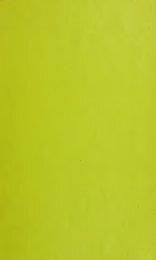Chapter-1 / Physiological Foundations - WHNLive Public Library
Chapter-1 / Physiological Foundations - WHNLive Public Library
Chapter-1 / Physiological Foundations - WHNLive Public Library
You also want an ePaper? Increase the reach of your titles
YUMPU automatically turns print PDFs into web optimized ePapers that Google loves.
1. <strong>Physiological</strong> foundationsAll"i1tIJ~illJo/s N 7 23 48 44 15UnstIPdedIlJt'f'sons.~ 35-45 46 -55 56-65 66-75 itS - 84 ~%20t/~15 ~10LiPiIJ-tJ150// "\..V~ .."Fig.51 The dependence on age of thegain in the lJ'O'_art before and after _02MT. The entire sample was a total of137 individuals; controls and patientsbetween 1977 and 1980; at the beginning,process management not yetoptimalAb. tJfidfi/uols N fI) 17 39 37 935-45 46-55 56-65 66 -75 76 ~84 Years1LiPo,-tJ1%25t----+---+- :--~-_l_----J20 l/'~_/ ....~15 r----+.~ ,:....-+---+---+--~10 ..,;t-....". .~---+---~-_l_----J5...---+---+---1-----+------1oL..-_---L.__....L-__L..-_.....J.._----JFig. 52 The dependence on age of the gainin the tJ'0 2 -art before and after 02 MT.The entire sample was a total of 103 individuals;controls and patients between1977 and 1980; at the beginning, processmanagement not yet optimalInfluence of age. Figure SO summarizes the percentageof nonresponders V for all treated persons,dependent on age. A dependency onage can be clearly seen, inasmuch as a lowerage limit can be defined, below which therapeuticsuccess, in the sense of a rise in P02-art,can only be expected in exceptional cases. Itcan further be seen that a positive responsewith a low nonresponder rate is possible in theage range from 46 to 75 years. Above this agegroup we must again reckon with a higher nonresponderrate.Figure 51 shows the relative gain in P0 2 -art as aper cent of the starting level for all examinedpersons. The drop in the gain in the oldestgroup is primarily a result of the higher nonresponderrate. If we therefore eliminate thenon-responders from the same population andpre ent the gain in the same way as in Fig. 52,then the gain should correspond to that of theyounger group. That is not the case, however,the figure how. The gain already dropso the age group of 66- to 75-year-old in-It is therefore probable that our procedureencounters limits here which are primarily pulmonarilyconditioned. The regeneration procedureno longer succeeds with full intensity incases of manifest, morphologically fixed disorders.This is expressed in increasing age atfirst only in a reduction in the attainable gain(Fig. 52, start of reduction already in the 66- to75-year group), whilst the nonre ponder raterises significantly with further increases in age(Fig. SO).Influence of P0 2 _ artunder O 2 inhalation. If wearrange our volunteers and patients accordingto the P0 2 - 11rt level reached under O 2 inhalation,we find a clear dependence of the nonresponderrate on the e level in that the nonresponderrate i greatly reduced with highP0 2- art levels, and increa ed with lower Ie 1.Such statements can only be valuated a tland quantitatively if the upply of O 2 i e tlcontrolled. Thi i not fully th a ith urvolunteers, a th oxygen wa appli d u ing thop n y tern (nozz! appli ator), 0 th t vari













